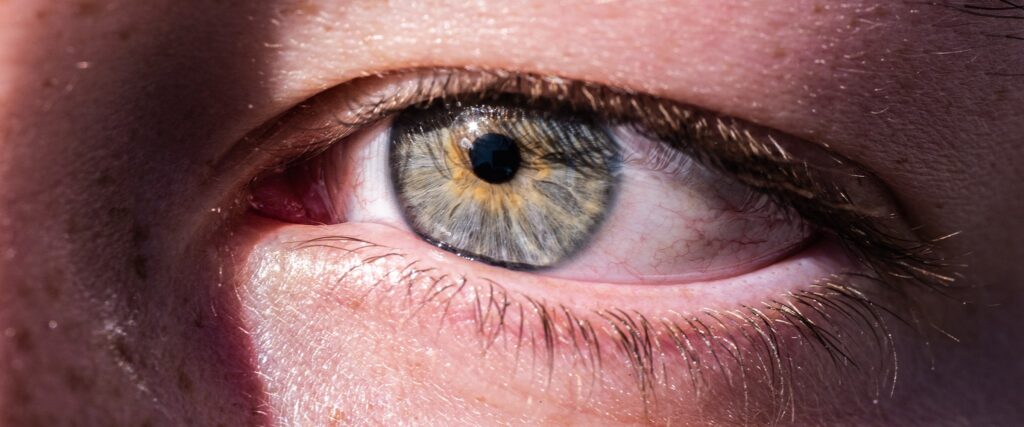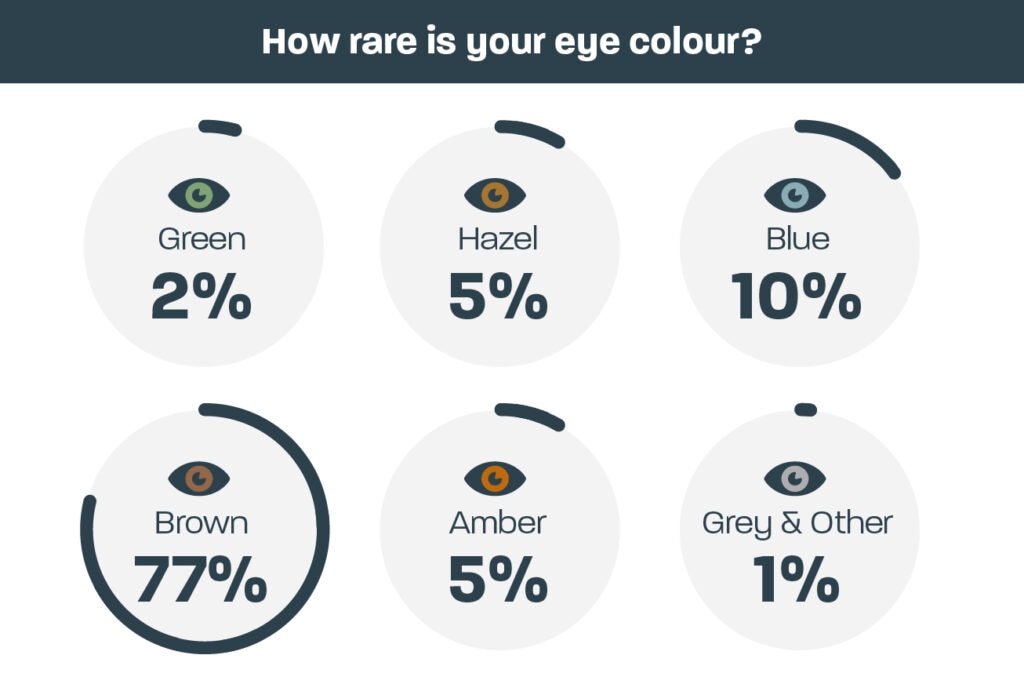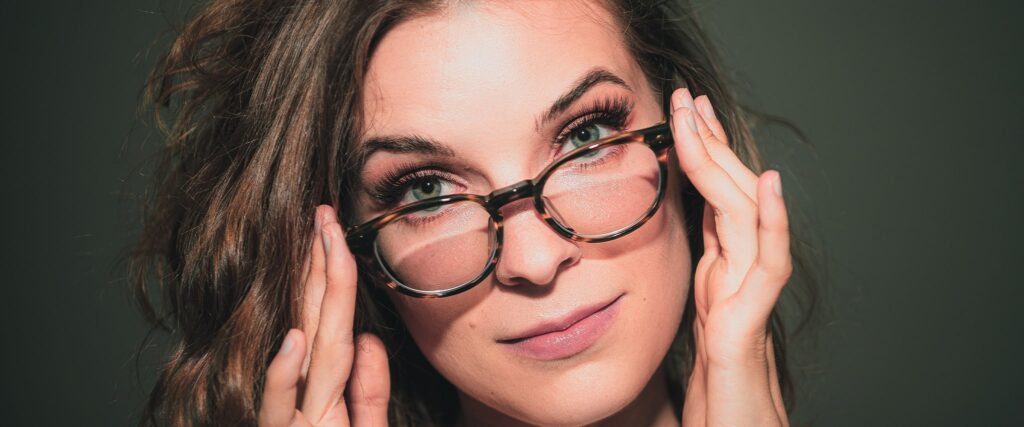As human beings, our eyes are one of our most distinctive features and they are often the first thing we notice about someone. They come in so many different colours. The most well-recognised are brown, blue, hazel and green eyes. Yet there are some other shades which are far more obscure. But what is the rarest eye colour? Well, as it turns out green eyes are surprisingly very rare and believe it or not, it’s actually possible for people to have violet or red eyes. In this blog post, we’ll talk more about the different eye colours and also how rare they are.

What determines your natural eye colour?
Colour variations in our eyes are caused by how much melanin there is in the front layer of the iris, which is the coloured part of your eye. The presence of melanin also determines your hair and skin colour. There are various factors that can control how much melanin is produced, including genetics.
Individuals with eyes that appear brown in colour will have a high proportion of melanin on the back and also the front of the iris. Meanwhile, eyes without melanin on the front part of the iris will appear lighter due to the fact they will have less pigmentation. Essentially, the more melanin there is, the darker your eyes will be.
Technically speaking, everyone has brown eyes because even eyes that look a light blue colour will have a brown pigment.
Learn more about rare eye colours
Brown and blue are the most common eye colours in the world. They are the two that come to mind right away. But deciding the rarest eye colour is a bit more difficult. To tell the truth, the numbers aren’t always well-defined, especially because they are so rare.
Around 1% of the world’s population has the most unique eye colours. Grey eyes are one of the rarest coloured eyes you can have. Often mistaken for being blue, they are not very common. Pink or light red eyes are also very unique and occur in individuals who have albinism.
The table below displays the approximate percentage of the world’s population who have each eye colour.

Top 5 rarest eye colours in the world
Violet or red eyes
When the iris has little to no pigmentation, your eyes will appear red or violet in colour. This is because blood vessels which are under the surface of your eyes become more visible in the light. This eye colour occurs as a result of albinism and is extremely rare. People with red or violet eyes will require greater protection from the sun.
Grey eyes
Grey eyes can be distinguished from blue due to the presents of brown specks in the iris. Blue eyes on the other hand tend to have yellow or gold specks. As is the case with lighter eye colours, there is very little melanin present in grey eyes. The reason they appear grey rather than blue is because of the high amount of collagen in the stroma. Furthermore, blue eyes will appear more vibrant, whilst grey eyes look somewhat cloudy.
Green eyes
Many people debate that green is actually the rarest eye colour, but most would agree red, violet and grey eyes are far lesser known. Green eyes do not have a large amount of melanin. This creates what is known as a Rayleigh scattering which results in light being reflected by the eyes rather than being absorbed by the pigment. It is an effect that makes your eyes appear green. Green eyes are a light brown colour with a yellow, golden or orange pigmentation called lipochrome.
Amber eyes
Often mistaken for hazel eyes, amber eyes are actually very rare. In fact, it is believed that only around 5% of the population has this eye colour. Amber eyes tend to be a yellowish-brown shade, sometimes they will even appear to have a golden or orange tone. The reason they are this colour is because they have a lot of the yellowish pigmentation known as lipochrome.
Hazel eyes
Hazel eyes come in many different variations but can usually be described as a yellowish-brown colour with gold, green, brown and even blue flecks. These types of eyes have the same amount of melanin as brown eyes but the major difference is that the melanin is spread out differently, appearing more around the edge of the iris instead of the middle. Hazel eyes reflect light beautifully and are very attention-grabbing. As is the case with green eyes, the colour is impacted by the Rayleigh scattering effect.

What are the most common eye colours?
Brown eyes
The most common eye colour is brown which comes in a variety of hues that range from dark to bright in colour. Often brown eyes can also appear black in some lights, despite this not being possible.
Studies have revealed that people with dark-brown eyes are at far greater risk of developing cataracts. However, some individuals argue that this connection could be more to do with hereditary traits than eye colour specifically. Even so, it is still important to remember that whatever your eye colour, you should take care. Make sure you wear the appropriate eyewear at all times and are protected from UV rays with a reliable pair of sunglasses.
Fun fact, it is actually a misconception that newborn babies have blue eyes. In truth, lots of babies are born with brown eyes!
Blue eyes
As the second most common eye colour in the world, blue eyes do not have a blue pigment, instead, they just have less melanin. For those of you with baby blues, it’s important to be aware that having blue eyes can make you more prone to diseases like age-related macular degeneration, cataracts and ocular cancer. Invest in suitable eyewear and make sure you have sunglasses with 100% UVA/B protection.

What factors can affect your eye colour?
Heterochromia is a rare condition that normally only impacts 1% of the population. This is when one iris appears a different colour to the other, for example, the person might have one blue and one brown eye.
Albinism is a genetic condition that impacts the amount of melanin an individual is able to produce in their skin, hair and eyes. People with albinism normally have pale blue, violet, pink, or red eyes.
Anisocoria is another kind of heterochromia which means an individual has one pupil bigger than the other. It can also mean one eye appears darker.
Arcus senilis is a more common condition and is a sign of ageing and high cholesterol. It results in a grey, blue, or white arc of fatty deposits that surround the cornea.
Cataracts occur when the lens of your eye becomes cloudier, commonly resulting in blurry vision. If your eyes have cataracts, they may look white or greyish.
Hyphema is when blood gathers within the front of the eye. Some or all of the iris and the pupil may be covered by blood, making your eye appear red. This condition is normally caused by sports injuries.
Uveitis can be defined very simply as inflammation within the eye. This can be caused by infection, toxins or a sports injury. The white of the eye may appear red.
What colour glasses suit my eye colour?
Brown, hazel or amber eyes are best complemented by warmer colours, like brown, tortoiseshell or earthy green. If you have hazel eyes with bright yellowy specks, a shiny gold frame will absolutely be your go-to. Alternatively, if you really want to turn heads, then go for brighter tones like blue or purple. You’ll also look smart and professional in a black-coloured frame.
Blue eyes naturally work well with blue, silver and grey hues. Meanwhile, tortoiseshell, honey or black frames will give you a tidy, everyday appearance. Blue eyes also nicely contrast vibrant oranges and reds.
Green eyes work nicely with dark brown, Havana and gold. They also contrast well with colours like pale pink, blue, or violet.
Grey eyes are complemented most by pastel colours, bright patterns and ombre frames. You can also achieve a stand-out look in black, dark blue and purple colours.
How can I change the colour of my eyes?
If there is a certain eye colour you’re keen to try, coloured eye contacts are a great solution. Perhaps, you would love to see how your eyes would look as a distinctive grey, violet or green. Change them according to your mood or try them on for a special occasion. There is a whole plethora of different coloured eye contacts to choose from!




